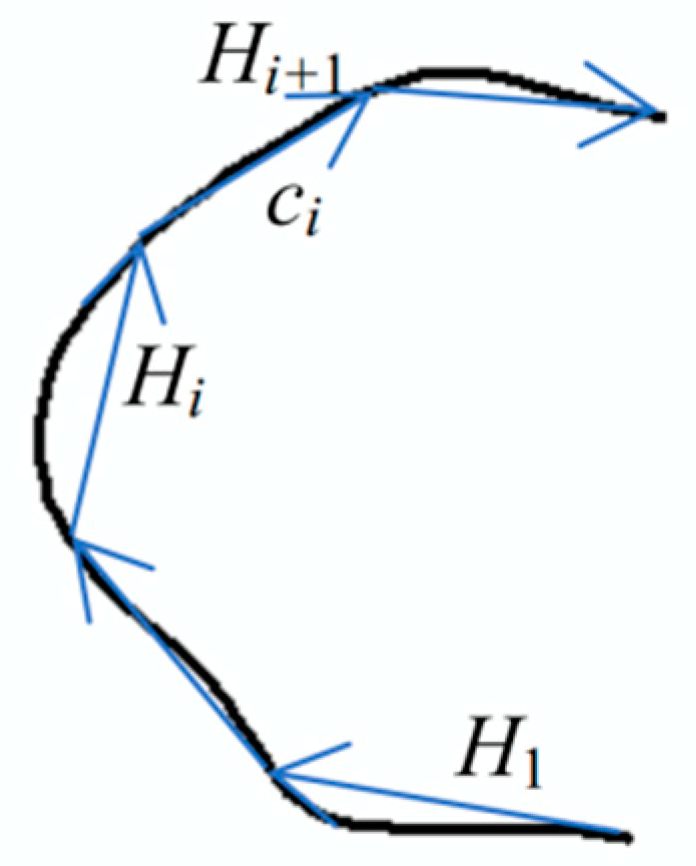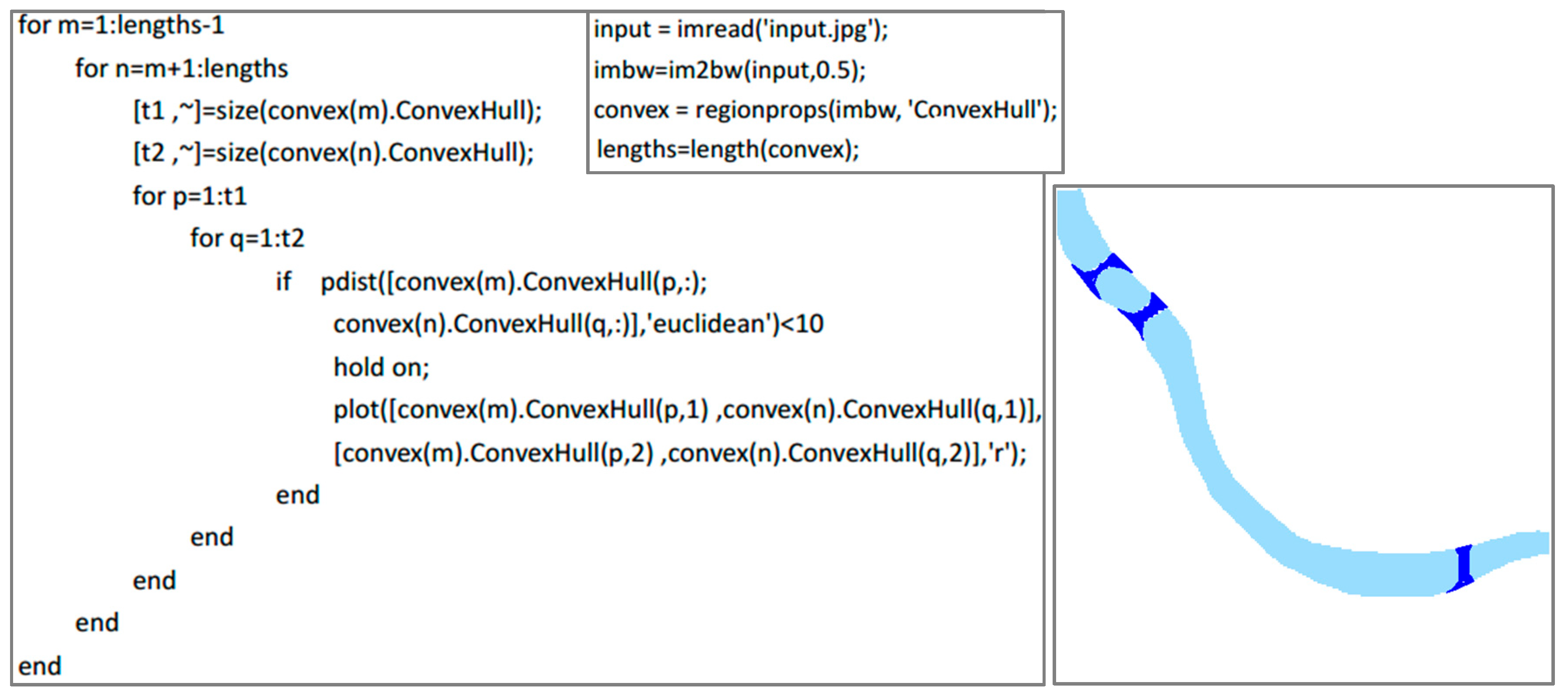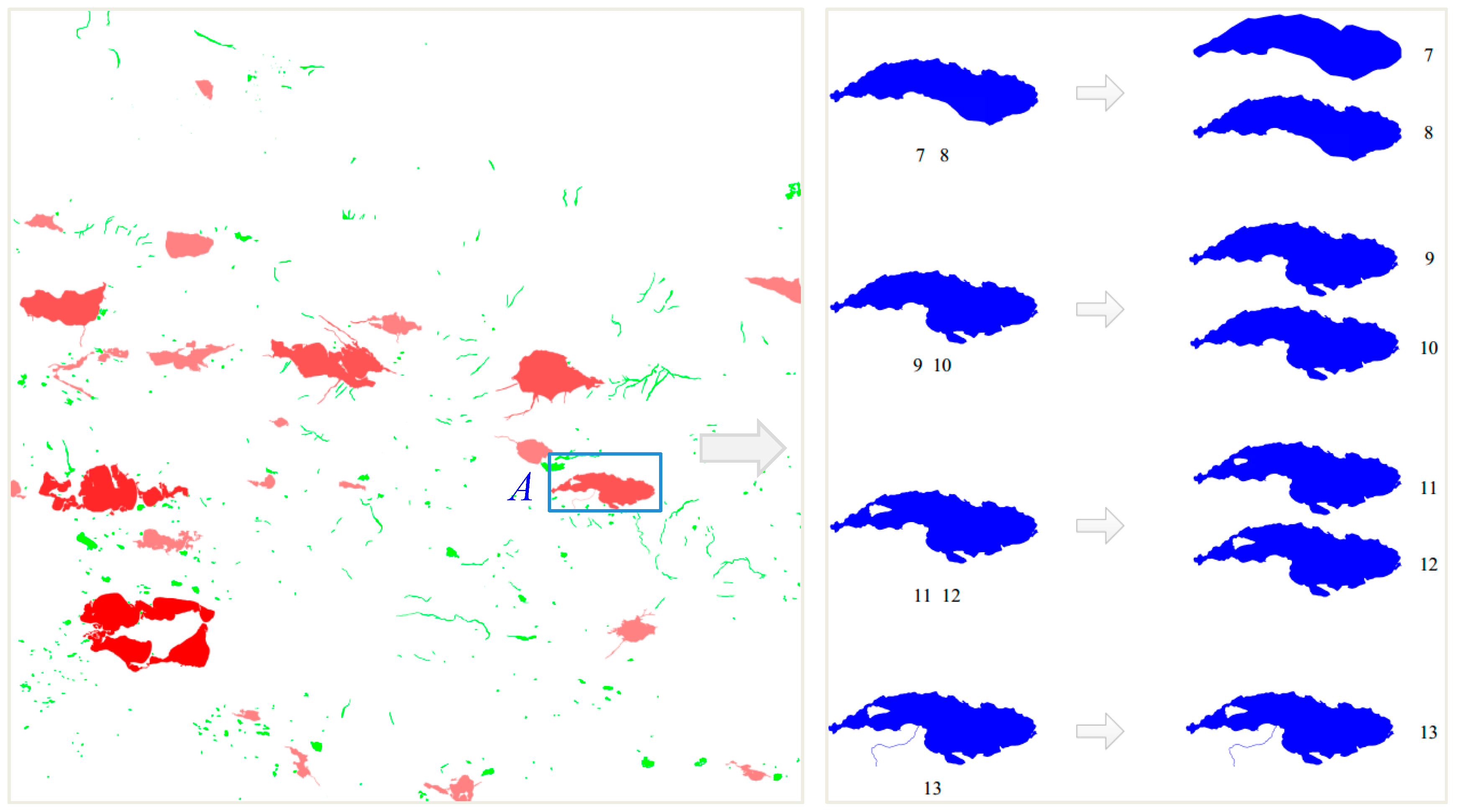A Raster-Based Methodology to Detect Cross-Scale Changes in Water Body Representations Caused by Map Generalization
Abstract
1. Introduction
2. Hierarchical Change Detection
2.1. Division of Detection Hierarchy
2.2. Body Layer
2.3. Piece Layer
2.4. Slice Layer
3. Change Classification and Detection of Water Area
3.1. Definition of Detection Indicators
3.2. Change Types and Detection Rules
3.2.1. Change Types
3.2.2. Detection Rules
3.2.3. Hierarchical Expression of Water Area Changes
4. Experiments and Analysis
4.1. Water Area Extraction and Reconstruction
- (1)
- Extract water areas with color segmentation
- (2)
- Fracture connection of water areas
- (3)
- Hole filling of the water areas
4.2. Study Area
4.3. Result and Analysis
- (1)
- Detection of change types
- (2)
- Hierarchical expression of change
5. Conclusions
Author Contributions
Funding
Acknowledgments
Conflicts of Interest
References
- Dumont, M.; Touya, G.; Duchêne, C. Assessing the variation of visual complexity in multi-Scale maps with clutter measures. In Proceedings of the 19th ICA Workshop on Generalisation and Multiple Representation, Helsinki, Finland, 14 June 2016. [Google Scholar]
- Dumont, M.; Touya, G.; Duchêne, C. Designing multi-scale maps: Lessons learned from existing practices. Int. J. Cartogr. 2020, 6, 121–151. [Google Scholar] [CrossRef]
- Stoter, J.; Zhang, X.; Stigmar, H.; Harrie, L. Evaluation in Generalisation. In Abstracting Geographic Information in a Data Rich World; Burghardt, D., Duchêne, C., Mackaness, W., Eds.; Springer: Cham, Switzerland, 2014; pp. 259–297. [Google Scholar]
- Mackaness, W.A.; Ruas, A. Evaluation in the Map Generalisation Process. In Generalisation of Geographic Information: Cartographic Modelling and Applications; Elsevier: Amsterdam, The Netherlands, 2007; pp. 89–111. [Google Scholar]
- Shen, Y.; Ai, T.; Wang, L.; Zhou, J. A new approach to simplifying polygonal and linear features using superpixel segmentation. Int. J. Geogr. Inf. Sci. 2018, 32, 2023–2054. [Google Scholar] [CrossRef]
- Shen, Y.; Ai, T.; Li, J.; Huang, L.; Li, W. A progressive method for the collapse of river representation considering geographical characteristics. Int. J. Digit. Earth 2020, 1–25. [Google Scholar] [CrossRef]
- Singh, A. Digital change detection techniques using remotely sensed data. Int. J. Remote Sens. 1989, 10, 989–1003. [Google Scholar] [CrossRef]
- Peled, A. Map and Database Revision. In Proceedings of the 18th Congress of the International Society for Photogrammetry and Remote Sensing, Vienna, Austria, 9–19 July 1996; pp. 645–649. [Google Scholar]
- Shen, Y.; Ai, T. A hierarchical approach for measuring the consistency of water areas between multiple representations of tile maps with different scales. ISPRS Int. J. Geo-Inf. 2017, 6, 240. [Google Scholar] [CrossRef]
- Bertolotto, M.; Egenhofer, M.J. Progressive transmission of vector data over the World Wide Web. GeoInformatica 2001, 5, 345–373. [Google Scholar] [CrossRef]
- Parent, C.; Spaccapietra, S.; Zimanyi, E. The MurMur project: Modeling and querying multi-representation spatio-temporal databases. Inf. Syst. 2006, 5, 733–769. [Google Scholar] [CrossRef]
- Duckham, M.; Lingham, J.; Mason, K.; Worboys, M. Qualitative reasoning about consistency in geographic information. Inf. Sci. 2006, 176, 601–627. [Google Scholar] [CrossRef]
- López-Caloca, A.; Tapia-Silva, F.O.; Escalante-Ramírez, B. Lake Chapala change detection using time series. Remote Sens. Agric. Ecosyst. Hydrol. 2008, 7104, 1–11. [Google Scholar]
- Rokni, K.; Ahmad, A.; Selamat, A.; Hazini, S. Water feature extraction and change detection using multitemporal landsat imagery. Remote Sens. 2014, 6, 4173–4189. [Google Scholar] [CrossRef]
- Li, J.; Narayanan, R.M. A shape-based approach to change detection of lakes using time series remote sensing. IEEE Trans. Geosci. Remote Sens. 2003, 41, 2466–2477. [Google Scholar]
- Aher, S.P.; Bairagi, S.I.; Deshmukh, P.P.; Gaikwad, R.D. River change detection and bank erosion identification using topographical and remote sensing data. Int. J. Appl. Inf. Syst. 2012, 2, 1–7. [Google Scholar]
- Du, Z.; Bin, L.; Ling, F.; Li, W.; Tian, W.; Wang, H.; Gui, Y.; Sun, B.; Zhang, X. Estimating surface water area changes using time-series Landsat data in the Qingjiang River Basin, China. J. Appl. Remote Sens. 2012, 6, 063609. [Google Scholar] [CrossRef]
- Li, X.; Damen, M.C.J. Coastline change detection with satellite remote sensing for environmental management of the Pearl River Estuary, China. J. Mar. Syst. 2010, 82, 54–61. [Google Scholar] [CrossRef]
- Alesheikh, A.A.; Ghorbanali, A.; Nouri, N. Coastline change detection using remote sensing. Int. J. Environ. Sci. Technol. 2007, 4, 61–66. [Google Scholar] [CrossRef]
- EI-Asmar, H.M.; Hereher, M.E. Change detection of the coastal zone east of the Nile Delta using remote sensing. Environ. Earth Sci. 2011, 62, 769–777. [Google Scholar] [CrossRef]
- Zhang, Z.; Lu, H.; Zhao, M. Water body extraction and change detection based on multi-temporal SAR images. In Proceedings of the SPIE 7498, MIPPR 2009: Remote Sensing and GIS Data Processing and Other Applications, Yichang, China, 30 October 2009; pp. 1–7. [Google Scholar]
- Visser, H.; De Nijs, T. The map comparison kit. Environ. Model. Softw. 2006, 21, 346–358. [Google Scholar] [CrossRef]
- McMaster, R.B.; Shea, K.S. Generalization in Digital Cartography; Association of American Geographers: Washington, DC, USA, 1992. [Google Scholar]
- AI-Rawashdeh, S.B. Evaluation of the differencing pixel-by-pixel change detection method in mapping irrigated areas in dry zones. Int. J. Remote Sens. 2011, 32, 2173–2184. [Google Scholar] [CrossRef]
- Li, Q.; Li, D. Big Data GIS. Geomat. Inf. Sci. Wuhan Univ. 2014, 39, 641–644. [Google Scholar]
- Zhang, X.; Yin, W.; Yang, M.; Ai, T.; Stoter, J. Updating authoritative spatial data from timely sources: A multiple representation approach. Int. J. Appl. Earth Obs. Geoinf. 2018, 72, 42–56. [Google Scholar] [CrossRef]
- Girres, J.F.; Touya., G. Quality assessment of the French OpenStreetMap dataset. Trans. GIS. 2010, 14, 435–459. [Google Scholar] [CrossRef]
- Müller, M.; Wiemann, S.; Grafe, B. A framework for building multi-representation layers from OpenStreetMap data. In Proceedings of the 15th ICA Workshop on Generalisation and Multiple Representation, Istanbul, Turkey, 13–14 September 2012; p. 10. [Google Scholar]
- Touya, G.; Brando-Escobar, C. Detecting level-of-detail inconsistencies in volunteered geographic information data sets. Cartogr. Int. J. Geogr. Inf. Geovisualization 2013, 48, 134–143. [Google Scholar] [CrossRef]
- Koestler, A. The Ghost in the Machine, 1st ed.; Macmillan Publisher: New York, NY, USA, 1968. [Google Scholar]
- Samet, H. The Design and Analysis of Spatial Data Structures, 1st ed.; Addison-Wesley Publisher: New York, NY, USA, 1990. [Google Scholar]
- Gooodchild, M.F.; Shiren, Y. A Hierarchical Spatial Data structure for global geographic information systems. Graph. Mod. Image Process. 1992, 54, 31–44. [Google Scholar] [CrossRef]
- Frank, A.U.; Timpf, S. Multiple representations for cartographic objects in a multi-scale tree-An intelligent graphical zoom. Comput. Graph. 1994, 18, 823–829. [Google Scholar] [CrossRef]
- Langacker, R.W. Foundations of Cognitive Grammar, 1st ed.; Stanford University Publisher: Stanford, CA, USA, 1987. [Google Scholar]
- Müler, J.C.; Zeshen, W. Area-patch generalisation: A competitive approach. Cartogr. J. 1992, 29, 137–144. [Google Scholar] [CrossRef]
- Cecconi, A. Integration of Cartographic Generalization and Multi-Scale Databases for Enhanced Web Mapping, 1st ed.; Zurich Publisher: Zurich, Switzerland, 2003. [Google Scholar]
- Shen, Y.; Ai, T.; Yang, M. Extracting centerlines from dual-line roads using superpixel segmentation. IEEE Access 2019, 7, 15967–15979. [Google Scholar] [CrossRef]
- Brewer, C.A.; Buttenfield, B.P. Mastering map scale: Balancing workloads using display and geometry change in multi-scale mapping. Geoinformatica 2010, 14, 221–239. [Google Scholar] [CrossRef]
- Buttenfield, B.P.; Stanislawski, L.V.; Brewer, C.A. Adapting generalization tools to physiographic diversity for the United States National Hydrography Dataset. Cartogr. Geogr. Inf. Sci. 2011, 38, 289–301. [Google Scholar] [CrossRef]
- Zhao, R.; Ai, T.; Yu, W.; He, Y.; Shen, Y. Recognition of building group patterns using Graph Convolutional Network. Cartogr. Geogr. Inf. Sci. 2020. [Google Scholar] [CrossRef]
- Shen, Y.; Ai, T.; Li, W.; Yang, M.; Feng, Y. A polygon aggregation method with global feature preservation using superpixel segmentation. Comput. Environ. Urban Syst. 2019, 75, 117–131. [Google Scholar] [CrossRef]
- Stanislawski, L.V.; Buttenfield, B.P.; Doumbouya, A. A rapid approach for automated comparison of independently derived stream networks. Cartogr. Geogr. Inf. Sci. 2015, 42, 435–448. [Google Scholar] [CrossRef]
- Shen, Y.; Ai, T.; Li, C. A simplification of urban buildings to preserve geometric properties using superpixel segmentation. Int. J. Appl. Earth Obs. Geoinf. 2019, 79, 162–174. [Google Scholar] [CrossRef]
- Shen, Y.; Ai, T.; He, Y. A new approach to line simplification based on image processing: A case study of water area boundaries. ISPRS Int. J. Geo-Inf. 2018, 7, 41. [Google Scholar] [CrossRef]
- Ai, T.; Yin, H.; Shen, Y.; Yang, M.; Wang, L. A formal model of neighborhood representation and applications in urban building aggregation supported by Delaunay triangulation. PLoS ONE 2019, 14, e0218877. [Google Scholar] [CrossRef]
- Bodansky, E.; Gribov, A.; Pilouk, M. Smoothing and compression of lines obtained by raster-to-vector conversion. In Graphics Recognition: Algorithms and Applications; Blostein, D., Kwon, Y.-B., Eds.; Springer: Heidelberg, Germany, 2002; pp. 256–265. [Google Scholar]
- Claramunt, C.; Thériault, M. Managing Time in GIS an Event-Oriented Approach, 1st ed.; Springer: London, UK, 1995. [Google Scholar]
- Raza, A.; Kainz, W. An object-oriented approach for modeling urban land-use changes. URISA J. 2001, 14, 37–55. [Google Scholar]
- Radke, R.J.; Andra, S.; AI-Kofahi, O.; Roysam, B. Image change detection algorithms: A systematic survey. IEEE Trans. Image Process. 2005, 14, 294–307. [Google Scholar] [CrossRef] [PubMed]
- Persoon, E.; Fu, K. Shape discrimination using Fourier descriptors. IEEE Trans. Pattern Anal. Mach. Intell. 1986, 8, 388–397. [Google Scholar] [CrossRef]
- Zahn, C.T.; Roskies, R.Z. Fourier descriptors for plane closed curves. IEEE Trans. Comput. 1972, c-21, 269–281. [Google Scholar] [CrossRef]
- Shi, W.; Cheung, C. Performance evaluation of line simplification algorithms for vector generalization. Cartogr. J. 2006, 43, 27–44. [Google Scholar] [CrossRef]
- Zhao, Y.; Chen, Y. Included angle chain: A method for curve representation. J. Softw. 2004, 15, 300–307. [Google Scholar]
- Tiandi Map. Available online: https://www.tianditu.gov.cn/ (accessed on 25 June 2020).
- Yang, M.; Ai, T.; Yan, X.; Yang, W.; Zhou, X.; Zhou, Q. Change detection and updating by using map overlay for buildings on multi-scale maps. Acta Geod. Cartogr. Sin. 2016, 45, 466–474. [Google Scholar]











| Change Type | Before Change | After Change | Change Type | Before Change | After Change |
|---|---|---|---|---|---|
| no change |  |  | appearance |  |  |
| disappearance |  |  | movement |  |  |
| rotation |  |  | scaling |  |  |
| morphology change | 1 append | hole change | 1 appear | ||
 |  |  |  | ||
| 2 distributary | 2 disappear | ||||
 |  |  |  | ||
| 3 shape change | 3 structure change | ||||
 |  |  |  | ||
| derivative change | 1 merge | boundary generalization |  |  | |
 |  | ||||
| 2 split | |||||
 |  | ||||
| Types | Operations | Relevant and Fixed | Relevant and Threshold | Rules |
|---|---|---|---|---|
| appearance and disappearance | null | MT | null | or . |
| movement | null | ; ; . | ||
| rotation | move until meeting centre and overlap | ; ; ; . | ||
| scaling | scaling to the same size and overlap | null | ; ; | |
| boundary generalization | overlap | ; ; ; ; . | ||
| morphology change: append | overlap | ; ; ; ; . | ||
| morphology change: distributary | overlap | ; ; ; . | ||
| morphology change: shape change | overlap | ; ; ; ; . | ||
| derivative change: merge | null | MT | null | |
| derivative change: split | null | MT | null | |
| hole change: appear and disappear | null | null | ; . | |
| hole change: structure change | null | ; ; ; . |
| 7–8 | 8–9 | 9–10 | 10–11 | 11–12 | 12–13 | Total | |
|---|---|---|---|---|---|---|---|
| appearance | 0 | 0 | 0 | 130 | 357 | 28 | 515 |
| disappearance | 0 | 0 | 0 | 0 | 5 | 1 | 6 |
| movement | 0 | 0 | 0 | 0 | 0 | 0 | 0 |
| rotation | 0 | 0 | 0 | 0 | 0 | 0 | 0 |
| scaling | 0 | 0 | 0 | 0 | 0 | 0 | 0 |
| boundary generalization | 2 | 0 | 0 | 0 | 0 | 0 | 2 |
| morphology change 1 | 0 | 2 | 3 | 0 | 0 | 5 | 10 |
| morphology change 2 | 0 | 0 | 0 | 0 | 9 | 4 | 13 |
| morphology change 3 | 0 | 2 | 1 | 0 | 0 | 0 | 3 |
| derivative change 1 | 0 | 0 | 0 | 0 | 0 | 0 | 0 |
| derivative change 2 | 0 | 0 | 0 | 7 | 2 | 0 | 9 |
| hole change 1 | 2 | 0 | 0 | 6 | 18 | 0 | 26 |
| hole change 2 | 0 | 0 | 0 | 0 | 0 | 0 | 0 |
| hole change 3 | 0 | 1 | 0 | 0 | 6 | 16 | 23 |
| Total | 4 | 5 | 4 | 143 | 397 | 54 | 607 |
| Level | 8–9 | 10–11 | 12–13 |
|---|---|---|---|
| Mutation type | morphology change 1 | hole change 1 | morphology change 2 |
| Level | 7–8 | 9–10 | 11–12 | 13 |
|---|---|---|---|---|
| Change type | boundary generalization | no change | hole change 3 | no change |
| difference | 0 | 0 |
© 2020 by the authors. Licensee MDPI, Basel, Switzerland. This article is an open access article distributed under the terms and conditions of the Creative Commons Attribution (CC BY) license (http://creativecommons.org/licenses/by/4.0/).
Share and Cite
Shen, Y.; Ai, T. A Raster-Based Methodology to Detect Cross-Scale Changes in Water Body Representations Caused by Map Generalization. Sensors 2020, 20, 3823. https://doi.org/10.3390/s20143823
Shen Y, Ai T. A Raster-Based Methodology to Detect Cross-Scale Changes in Water Body Representations Caused by Map Generalization. Sensors. 2020; 20(14):3823. https://doi.org/10.3390/s20143823
Chicago/Turabian StyleShen, Yilang, and Tinghua Ai. 2020. "A Raster-Based Methodology to Detect Cross-Scale Changes in Water Body Representations Caused by Map Generalization" Sensors 20, no. 14: 3823. https://doi.org/10.3390/s20143823
APA StyleShen, Y., & Ai, T. (2020). A Raster-Based Methodology to Detect Cross-Scale Changes in Water Body Representations Caused by Map Generalization. Sensors, 20(14), 3823. https://doi.org/10.3390/s20143823






